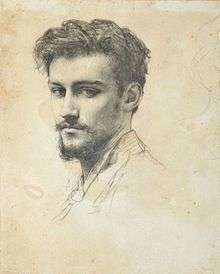Paul Grandhomme

Paul Grandhomme was a French medalist, engraver and enameller.[1] Born in Paris in 1851, he died in Saint-Briac-sur-Mer in 1944.[1]
Life
He was originally trained as a jeweller, but the 1871 Franco-Prussian war forced him to become a librarian.[2] This proved to be the start of his enamelling career as, after reading Claudius Popelin’s history of enamelling, Grandhomme became fascinated by the technique. After studying with Auguste Mollard and Jules-Clément Chaplain, he worked with Pierre Puvis de Chavannes and Jules-Élie Delaunay, and was influenced by his friend and fellow artist, Raphaël Collin.[3] In 1874 he presented work at the Salon of French Artists (Salon des artistes français), an enamel portrait of Vittoria Colonna.
In 1877 he began to collaborate with his pupil Alfred Jean Garnier, and together they presented further work at the Salon des artistes français, including a Virgin in the style of Carlo Crivelli, and a portrait of Edward VII. Together they won the gold medal at the 1889 Universal Exhibition in Paris.[2] They were also the last enamellers to collaborate with Gustave Moreau.[2]
Another frequent collaborator of Grandhomme's was Jules Brateau, a silversmith and metal-worker.[2] Grandhomme used his flat as his studio, with his dining room as the main area of work, and using a furnace in his kitchen to bake the enamel.[4]
He is buried in Saint-Briac-sur-Mer. His tomb is topped by a bronze statue created by Émile Armel-Beaufils and his wife.
Works
Grandhomme worked mainly in the Limoges School Revival style.[5]
A variety of Grandhomme's work is displayed at the Musée d'Orsay, including a series of enamelled tableaux on Greek mythological themes that he created with Garnier in the style of Gustave Moreau.[6] Two of his enamelled medals are on show at the Metropolitan Museum of Art.[7] A pre-World War I commemorative medal he made was part of a Victoria and Albert Museum exhibition on 'European Commemorative Medals for the Great War'.[3]
References
- 1 2 "Musée d'Orsay: Artists - biographical notes". www.musee-orsay.fr (in French). Retrieved 2015-05-29.
- 1 2 3 4 "Paul Grandhomme and Jules Brateau - 'ANDROMEDA', PLAQUE, 1900". www.sothebys.com/. Sotheby's. Retrieved 4 February 2016.
- 1 2 "Prix Du Ministre de la Guerre (War Office) | Grandhomme, Paul | V&A Search the Collections". collections.vam.ac.uk. Retrieved 2016-02-04.
- ↑ Calmettes, Pierre (1903). ""La Pognée: a new artistic society in Paris."". The Architectural Record: A Monthly Magazine of Architecture and the Allied Arts and Crafts. 13.
- ↑ Speel, Erika (1998). Dictionary of Enamelling: History and Techniques. Ashgate Publishing Limited. p. 69. ISBN 1859282725.
- ↑ "Musée d'Orsay: Collections catalogue - search results". www.musee-orsay.fr (in French). Retrieved 2015-05-29.
- ↑ "Search results | The Metropolitan Museum of Art". The Metropolitan Museum of Art, i.e. The Met Museum. Retrieved 2015-05-29.